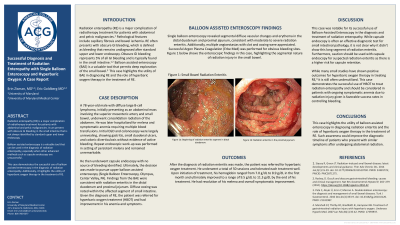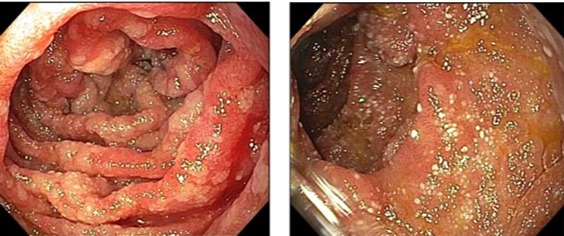Back


Poster Session C - Monday Afternoon
Category: Small Intestine
C0675 - Successful Diagnosis and Treatment of Radiation Enteropathy With Single Balloon Enteroscopy and Hyperbaric Oxygen: A Case Report
Monday, October 24, 2022
3:00 PM – 5:00 PM ET
Location: Crown Ballroom

Has Audio

Erin Zisman, MD
University of Maryland Medical Center
Baltimore, MD
Presenting Author(s)
Erin Zisman, MD, Eric Goldberg, MD
University of Maryland Medical Center, Baltimore, MD
Introduction: Radiation enteropathy (RE) is a major complication of radiotherapy treatment for patients with abdominal and pelvic malignancies. Intestinal damage is due to disruption of angiogenesis, leading to capillary fibrosis and bowel ischemia. These pathologic changes can present clinically as small bowel obstruction from luminal stenosis or obscure GI bleeding (undiagnosed after upper endoscopy (EGD) and colonoscopy), which represents 5% of all GI bleeding and is typically found in the small intestine. However, endoscopy of the small bowel is challenging given its length. Deep enteroscopy via balloon assisted enteroscopy (BAE) is a valuable tool that permits exploration of the small bowel, especially given the risks associated with capsule endoscopy (CE) in patients with suspected RE. This case highlights the utility of BAE in diagnosing RE, and such awareness could improve the diagnostic timeline of patients who present with similar symptoms after undergoing abdominal radiation.
Case Description/Methods: A 78-year-old male with diffuse large B-cell lymphoma involving the small bowel, underwent consolidation radiation of the abdomen. He was later hospitalized for melena and symptomatic anemia requiring transfusions. Both initial and repeat endoscopic work-up showed no evidence of active bleeding. CE was also performed and did not identify a source of bleeding. Ultimately, Single Balloon Enteroscopy (Olympus, Center Valley, PA) was pursued and revealed segmental diffuse lymphangiectasia and erythema in the distal duodenum and proximal jejunum, changes consistent with moderate to severe RE. Additionally, multiple angioectasias with oozing were appreciated and successful Argon Plasma Coagulation (Erbe Med) in focal areas was performed. Given a diagnosis of RE, the patient was referred for hyperbaric oxygen therapy (HBOT) which led to resolution of his bleeding and symptomatic improvement.
Discussion: This case was notable for its successful use of Balloon-Assisted Enteroscopy in the diagnosis and treatment of radiation enteropathy. While capsule endoscopy was utilized, it was unsuccessful in making the correct diagnosis and put the patient at risk for capsule retention. Furthermore, while many small studies have shown positive outcomes of HBOT in treating RE, it is still often underutilized. This case demonstrates the successful use of HBOT to treat RE and should be considered in patients with ongoing symptomatic anemia due to radiation injury given its favorable success rates in terminating bleeding.

Disclosures:
Erin Zisman, MD, Eric Goldberg, MD. C0675 - Successful Diagnosis and Treatment of Radiation Enteropathy With Single Balloon Enteroscopy and Hyperbaric Oxygen: A Case Report, ACG 2022 Annual Scientific Meeting Abstracts. Charlotte, NC: American College of Gastroenterology.
University of Maryland Medical Center, Baltimore, MD
Introduction: Radiation enteropathy (RE) is a major complication of radiotherapy treatment for patients with abdominal and pelvic malignancies. Intestinal damage is due to disruption of angiogenesis, leading to capillary fibrosis and bowel ischemia. These pathologic changes can present clinically as small bowel obstruction from luminal stenosis or obscure GI bleeding (undiagnosed after upper endoscopy (EGD) and colonoscopy), which represents 5% of all GI bleeding and is typically found in the small intestine. However, endoscopy of the small bowel is challenging given its length. Deep enteroscopy via balloon assisted enteroscopy (BAE) is a valuable tool that permits exploration of the small bowel, especially given the risks associated with capsule endoscopy (CE) in patients with suspected RE. This case highlights the utility of BAE in diagnosing RE, and such awareness could improve the diagnostic timeline of patients who present with similar symptoms after undergoing abdominal radiation.
Case Description/Methods: A 78-year-old male with diffuse large B-cell lymphoma involving the small bowel, underwent consolidation radiation of the abdomen. He was later hospitalized for melena and symptomatic anemia requiring transfusions. Both initial and repeat endoscopic work-up showed no evidence of active bleeding. CE was also performed and did not identify a source of bleeding. Ultimately, Single Balloon Enteroscopy (Olympus, Center Valley, PA) was pursued and revealed segmental diffuse lymphangiectasia and erythema in the distal duodenum and proximal jejunum, changes consistent with moderate to severe RE. Additionally, multiple angioectasias with oozing were appreciated and successful Argon Plasma Coagulation (Erbe Med) in focal areas was performed. Given a diagnosis of RE, the patient was referred for hyperbaric oxygen therapy (HBOT) which led to resolution of his bleeding and symptomatic improvement.
Discussion: This case was notable for its successful use of Balloon-Assisted Enteroscopy in the diagnosis and treatment of radiation enteropathy. While capsule endoscopy was utilized, it was unsuccessful in making the correct diagnosis and put the patient at risk for capsule retention. Furthermore, while many small studies have shown positive outcomes of HBOT in treating RE, it is still often underutilized. This case demonstrates the successful use of HBOT to treat RE and should be considered in patients with ongoing symptomatic anemia due to radiation injury given its favorable success rates in terminating bleeding.

Figure: Enteroscopic findings of segmental radiation injury in the small bowel using Single Balloon Enteroscopy.
Disclosures:
Erin Zisman indicated no relevant financial relationships.
Eric Goldberg: Ambu – Consultant. Medtronic – Consultant.
Erin Zisman, MD, Eric Goldberg, MD. C0675 - Successful Diagnosis and Treatment of Radiation Enteropathy With Single Balloon Enteroscopy and Hyperbaric Oxygen: A Case Report, ACG 2022 Annual Scientific Meeting Abstracts. Charlotte, NC: American College of Gastroenterology.

